Fundamentals
8 Rhythmic and Rest Values
Chelsey Hamm; Mark Gotham; and Bryn Hughes
Key Takeaways
- Notes consist of several different components, including a notehead, stem, beam, and flag.
- Common note values include the whole note, half note, quarter note, eighth note, and the sixteenth note.
- Common rest values include the whole rest, half rest, quarter rest, eighth rest and the sixteenth rest.
- British terms for note and rest values are different from American terms.
- A dot increases the duration of a note by half. Subsequent dots add half the duration of the previous dot.
- A tie connects two or more notes of the same pitch. Do not rearticulate any “tied to” notes.
Music is a temporal art; in other words, time is one of its components. That being the case, organizing time is essential for Western musical notation. Two temporal facets will be focused on in the next several chapters; rhythm and meter. This chapter focuses on the basic rhythmic and rest values in Western musical notation.
Rhythmic Values
Broadly speaking, rhythm refers to the duration of musical sounds and rests in time. As you’ll recall in the chapter titled Notation of Notes, Clefs, and Ledger Lines, notes may contain several different components, as seen in Example 1:
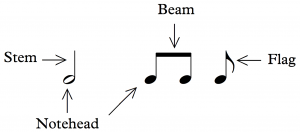
There are many common rhythmic values in Western musical notation. Rhythmic values are hierarchical; in other words, their lengths are relative to one another. Each rhythmic value can be divided into two subsequent rhythmic values, as seen in Example 2:
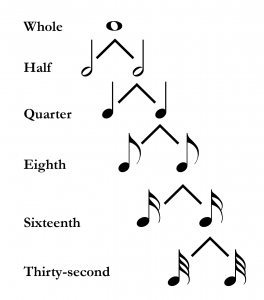
It is easy to think about these relationships like a pizza. A whole pizza divides into two halves, four quarters, eight eighths, etc. Likewise, a whole note divides into two halves, four quarters, eight eighths and so on.
Several additional aspects of Example 2 should be noted:
- Noteheads can be filled in (black) or unfilled (white); quarter notes and shorter durations are filled in.
- Unfilled noteheads may or may not have a stem, but filled noteheads always have stems.
- Flags are only added to the stems of filled noteheads.
Additionally, there are three ways to decrease a note’s value duration by half:
- Adding a stem to a note (i.e. whole to half) decreases a note’s duration by half.
- Filling in a notehead (i.e. half to quarter) decreases a note’s duration by half.
- Adding a flag (i.e. quarter to eighth or eighth to sixteenth) decreases a note’s duration by half.
Please note that Open Music Theory privileges the North American names for rhythmic values. Below, each rhythmic value will be discussed, and will be identified with the British name in parentheses; see Example 2 for a visual of each note value:
- Whole note (semibreve in British English): this thick, unfilled oval shape has no stem. In many compositions today, this is the longest note value used.
- Half note (minim in British English): also an oval, drawn with a slightly thinner line, and has a stem. This notes is half as long as the whole note (i.e. two half notes make up one whole note).
- Quarter note (crotchet in British English): looks like the half note, except that the note head has been filled in. This note is half as long as a half note (i.e. two quarter notes make up one half note), and is a quarter as long as a whole note (i.e. four quarter notes make up one whole note).
- Eighth note (quaver in British English): looks like the quarter note, except that a flag has been added to its stem. This note is half as long as a quarter note (i.e. two eighth notes make up one quarter note), and it is an eighth as long as a whole note (i.e. eight eighth notes make up one whole note).
- Sixteenth note (semiquaver in British English): looks like an eighth note, except that it has an extra flag. This note is half as long as an eighth note (i.e. two sixteenth notes make up one eighth note), and it is one sixteenth as long as a whole note (i.e. sixteen sixteenth notes make up one whole note).
Note values shorter than the sixteenth note (thirty-second note, sixty-fourth note, etc.) are created by adding extra flags. You may run into one additional, less common rhythmic value, called the double whole note (breve in British English). Example 3 shows one double whole note in a percussion clef, a clef used by non-pitched percussion instruments:
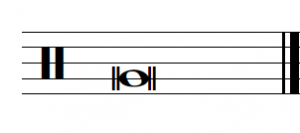
Double whole notes are sometimes notated with only one line on either side of the notehead. In older musical notation styles (e.g. mensural notation), the notehead appears more square than oval. Double whole notes divide into whole notes (i.e. two whole notes make up one double whole note).
Rest Values
Broadly speaking, rests refer to the duration of silences in music. Each hierarchical rhythmic value has a corresponding rest value, as seen in Example 4:
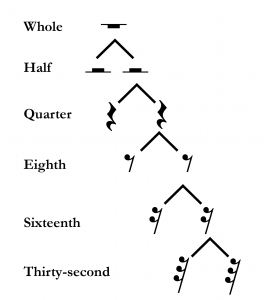
Like rhythmic note values, each rest value can be divided into two subsequent rest values, as seen in Example 4.
Several additional aspects of Example 4 should be noted:
- Notice that a whole rest hangs down from a line while a half rest sits on top of a line. It may be helpful to think of a whole rest as “heavier” than a half rest, which is why it hangs down; likewise, a half rest resembles a top hat, which is why it sits on top of a line, as if sitting on the top of a person’s head.
- Practice drawing quarter rests carefully; they are difficult to draw for many students.
- Adding a flag to a rest (i.e. eighth to sixteenth) decreases a rest’s duration by half.
Although rare, you may run across a breve rest, as seen in Example 5:
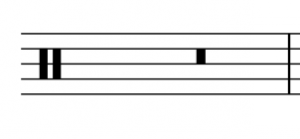
A breve rest is equivalent in length to two whole rests. It looks like a filled-in box, and appears on the second-from-top space.
Dots and ties
Dots and ties allow rhythmic and rest durations to be lengthened. A dot is written immediately after a note or rest, and it increases its duration by half. For example, a quarter note is equivalent in duration to two eighth notes; therefore, a dotted quarter note would be equivalent to three eighth notes. A second example: a whole note is equivalent to two half notes; therefore, a dotted whole note would be equivalent to three half notes. Multiple dots can be added to a duration. Subsequent dots add half the duration of the note that was added with the previous dot. For example, a double dotted quarter note (i.e. a quarter note with two dots) is equivalent in duration to a quarter, eighth, and sixteenth note. In other words, a doubly dotted note is 1 and 3/4 the durational value of the original note. Example 6 shows the rhythmic value breakdown of two dotted notes and one doubly dotted note:
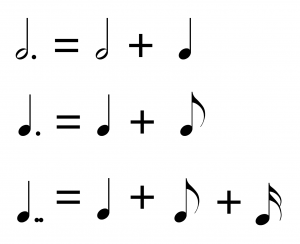
A tie is a curved line that connects two or more pitches that are the same. Tied-to notes are not rearticulated. In other words, ties are used to increase a rhythmic or rest value. Example 7 contains a tie:
Example 7. A tie connects the first two notes.
In Example 7 there is a tie connecting the first two rhythmic values. This tie indicates that the half and quarter notes are to be played or sung with no rearticulation of the quarter note. In other words, one should hold the first note for the duration of three quarter notes instead of two. Another way to write this rhythmic value is as a dotted half note. You might think that a tie looks like a slur (see Other Aspects of Notation). You would be correct in thinking they look alike. The difference between a tie and slur like in what pitches they connect, as well as their functions. Slurs connect notes of different pitches and serve as a reminder to play or sing the indicated notes legato, while ties connect notes of the same pitch and serve to increase the rhythmic value of a note.
- Note Durations (musictheory.net)
- Rhythmic Values (learnmusictheory.net)
- Note Values (Essentials of Harmony)
- Dots and Ties (YouTube)
- Dots and Ties (musictheory.net)
- Rhythmic Equations with Whole and Half Notes (.pdf)
- Rhythmic Equations with Half, Quarter, and Eighth Notes (.pdf)
- Rhythmic Equations with Quarter and Eighth Notes (.pdf)
- Rhythmic Equations with Quarter, Eighth, and Sixteenth Notes (.pdf)
- Writing Notes and Rests, Rhythmic Equations, pp. 3–7 (.pdf)
- Advanced Rhythmic Equations, p. 3 (.pdf)
- Slurs and Ties (.pdf)
Includes both a pitch and rhythmic component; may include a stem, beam, and/or flag
The elliptical part of the note that can be either filled in (black) or outlined (white)
The vertical line that originates at the notehead
The horizontal lines that connect certain groups of notes together
A curved line placed at the end of a stem
Divides into two half notes
Divides into two quarter notes
Divides into two eighth notes
Divides into two sixteenth notes
Divides into two thirty-second notes
Divides into two half rests
Divides into two quarter rests
Divides into two eighth rests
Divides into two sixteenth rests
Divides into two thirty-second rests
Increases a note or rest value by half
Connects two or more notes of the same pitch; do not rearticulate any "tied to" notes
Relating to time
The duration of musical sounds and rests in time
A recurring pattern of accents that occur over time; meters are notated with a time signature
Represent the relative values of notes
Arranged according to rank
Divides into two whole notes
A clef used by non-pitched percussion instruments, where each line or space is dedicated to a different sound
The duration of silences in music

